Subtotal: $
Checkout-

Inside Nyansa Classical Community
-

Watching the Geminids
-

A World Full of Signs
-

Covering the Cover: The Riddle of Nature
-

Back from Walden Pond
-

Can Masculinity Be Good?
-

Nature Is Obsessed with Me
-

Ancient Songs in the Desert
-

The Sadness of the Creatures
-

Meeting the Wolf
-

Saskatchewan, Promised Land
-

The Plants Can Talk
-

Saving the Soil, Saving the Farm
-

The Wonder of Moths
-

The Leper of Abercuawg
-

Dandelions: An Apology
-

A Wilderness God
-

Why I Hunt
-

Reading the Book of Nature
-

Breakwater
-

Lambing Season
-

Earthworks Urban Farm
-

Are You a Tree?
-

Practicing Christianity
-

Who Gets to Tell the Story?
-

A Medievalist Looks for the Image of Christ
-

In Defense of Chastity
-

Poem: “Let Them Grow”
-

Poem: “Squall”
-

Readers Respond

GEDs for Myanmar Migrants
Partners Relief & Development is working to establish a new educational program in Thailand.
By Rebecca Newton
May 11, 2024
Next Article:
Explore Other Articles:
A year ago, I came to Chiang Mai, Thailand, with Partners Relief & Development to help start a GED (General Educational Development Test) program for Myanmar migrants. For several years, the organization had provided computer studies and language classes including English, Thai, and Chinese, giving young adults skills that can help them secure better jobs, but the teachers realized that many students had never completed a formal education.
I spent the first three months recruiting students and developing a curriculum covering the subjects on the American GED exams: math, science, social studies, and language arts. Because the GED exam is recognized by the United States, Canada, Australia, and many Asian countries, it gives the students a chance to apply to university and train in professional fields.
The mission of Partners Relief & Development is to help children affected by conflict live “free, full lives.” Projects in Myanmar, Thailand, and the Middle East enable local communities to provide the security and resources children need in order to thrive. That is where the GED program fits in: my students dream of going back to their villages as educators, health care providers, or leaders.
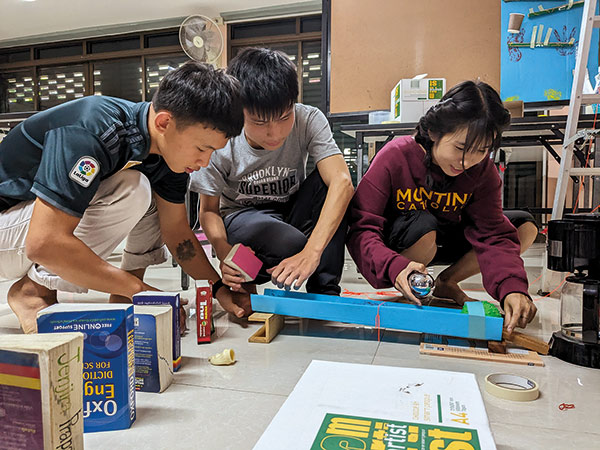
Young migrants from Myanmar work toward their GEDs. All photographs courtesy of Partners Relief & Development.
The students’ ages range from sixteen to thirty-two; the majority are in their early twenties. Most come from remote farming villages where their parents struggle to raise crops in poor soil and are often unable to sell their produce due to warfare and social instability. At least half of our students left home as schoolchildren, either to live in a town with a school or in a Buddhist monastery as novice monks, because their parents were determined that their children should have a better education.
The SEED School opens at 8:30 a.m., shortly before the students start to arrive by motorbike, bicycle, or foot. My morning class consists of ten students who mostly have jobs during the afternoon or at night. We start by watching a short clip of world news and discussing how it relates to the subjects we are studying. Then we study until noon.
Our students are used to rote memorization, with corporal punishment meted out for mistakes and questions, so it has been exciting to introduce them to critical thinking, to celebrate questions as the key to learning. Many of the topics we cover, from geography to genetics, are completely new to them, and they are eager to engage with each lesson. The first time a twenty-five-year-old student saw a globe, he told me, “I just want to sit here and look at this all the time.” Other students were amazed to learn that our physical appearance is not determined by what we did in a past life, but rather by genetic information passed on from our parents. Examining the founding documents of American government with young people who have grown up under military dictatorship and the chaos of civil war has made me look with new eyes at ideals we in the West take for granted.
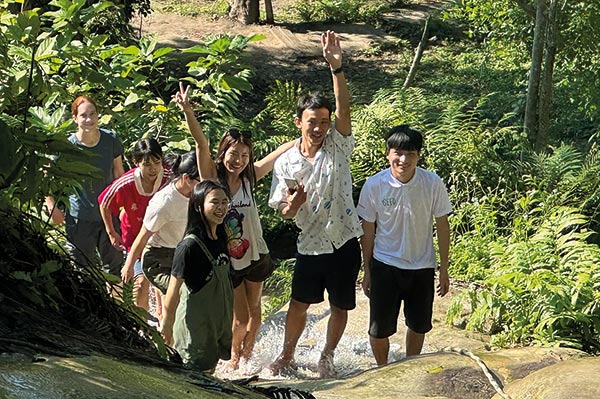
Rebecca Newton, left, with some of her students.
I try to incorporate as much group learning as possible, because the students have such a wide range of English abilities and levels of schooling. They often choose to stay on after class and continue studying together for several hours before they have to go to work.
At noon, we take our motorbikes to the local market to buy lunch, and then come back to study some more. On paper, the next few hours are my prep time, but they more often turn into one-on-one tutoring sessions, or a chance to ask individual students how they are doing and try to encourage them through the various challenges they face, either academically or out of school. Toward the end of the afternoon, I take a break, because three times a week I come back to teach an evening group of GED students, who mostly work six if not seven days a week in construction, restaurants, gas stations, or factories.
Even if I am feeling tired, the minute the students walk in, their enthusiasm reenergizes me. They look out for each other and tease each other like siblings. Because their work schedules keep them so busy, school is both education and social life.
It is rewarding to teach students who are so hungry to learn. I have gained insights into their culture and the incredible obstacles they have overcome: losing parents to sicknesses that should have been treatable, seeing fathers turn to alcoholism when they lost everything in military raids, leaving home as six-year-olds because their parents were determined that they should get an education, moving schools multiple times as the fronts in the civil war shifted, uprooting from their home and culture and trying to make their way as second-class citizens in a country with a different language and customs, working long hours to support not only themselves but their families back in Myanmar.
These young people have stepped into such heavy responsibilities that they have missed out on much of the fun and friendships and opportunities that I associate with my teen years. I try to weave those opportunities into our program with hands-on experiments and projects, occasional class trips, or a chance to cook and share a meal together.
One of my new students, a sixteen-year-old, had missed some classes, having difficulty traveling to Thailand from Myanmar, so I took a few hours one afternoon to work through some math and social studies concepts. At the end, I asked him, “Do you have any more questions?” He was quiet, and I could see him searching for words to formulate his thought. Then he asked me, “How can we teach our children to grow up to be better people?”
Caught off guard, I acknowledged that this was a big question, but that to my mind, the most important way forward is to lead by example, to model compassion, and to teach others to think for themselves (something that is discouraged under his homeland’s dictatorship). I asked, “Do you want to be a teacher?” He responded, “I want to be a teacher and a leader, because there are so many things that are not good in our country, and I want to help my people.”
These are the visionaries I am privileged to walk alongside as they study and work and hope for a brighter future for their people.
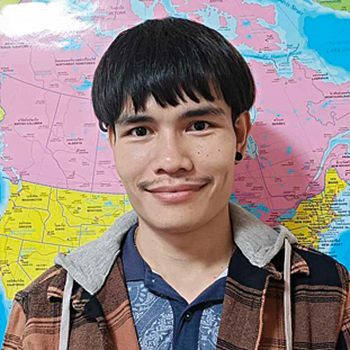
My name is Sai Saw. I was born in a small village in Shan State. We are six people in my family. My parents are farmers. We lived in a small bamboo house near the mountain. There were no hospitals or schools and no electricity in my village. When I was young, I didn’t have the opportunity to attend school, because it was very far from my village and if you want to attend, you have to pay a lot of money. One day in the morning when I was feeding buffaloes on the farmland, just like every day, my mother said to me, if you want to learn how to read and write in Shan, I will take you to live at the temple. Five days later she took me to the temple near our village. I lived there almost ten years.
One morning the Burmese soldiers came to my village. They killed our buffalo and our cows, and burned down our house. The situation was very bad, so my mother sent me to live with my brother in Thailand.
My first job in Thailand was at a gas station. After two years, I became a factory worker. I worked in the daytime, and in the evening, I came to study English at SEED School, but it was very difficult for me, because in the past I had never been to school. I think I am a lucky person that I found SEED School.
I wanted to join the GED program, because I want to improve my English. I also want to meet new people and learn new ideas. After I finish my education, I want to bring the knowledge I learn from the university and go back to teach the children in my village. I hope I can do that.
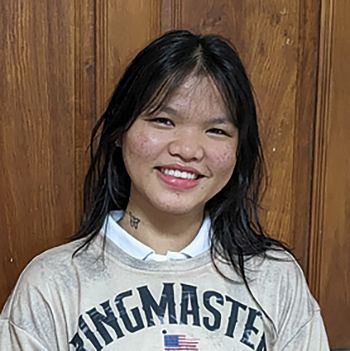
My name is Nan Hla. I am seventeen years old and I was born in Tachileik. When I was five years old I moved to Hekel Village in Myanmar. I studied at Hekel School until seventh grade. In 2018 I came to Thailand because my mother and grandmother had problems, but I didn’t want to come to Thailand because I knew I would have to work. I wanted to continue studying, so my mother said she would let me study in Thailand and she brought me.
When I arrived, I didn’t actually study, because my family didn’t have the money to send me to school. That is why I have to work. In 2022, my friend recommended SEED School to me. Then I applied to study English and Chinese. I work during the day and go to school in the evening. I started studying English and now I am studying GED in the evenings because I want to go to university. I think it is suitable for me because I can study while working. I can also follow my dream.
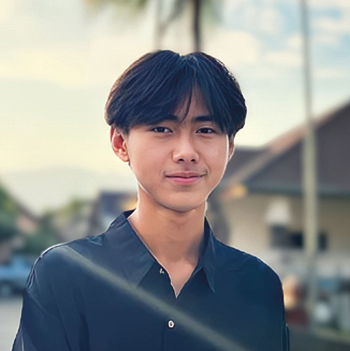
My name is Sai Seng Li. I am sixteen. I grew up in a small village far from the town: Namlan, Northern Shan State, Myanmar. There are seven people in my family. There are my grandparents, my parents, and two siblings. My parents are farmers. And this is about my journey of education. I began my education in my village when I was five years old. Later, I moved to live in a town to attend the government school at the age of nine, spending five years there, until grade seven. At that time Covid had come, so the school did not open.
I made up my mind to attend the national school at age fourteen, but I had to repeat grade seven. However, my teacher, my friends and l could not live in a single place for a long time. Due to the conflict between different groups of soldiers, we often had to move to a new place where it is peaceful and safe. I attended that school for three years in four different places.
I have a dream to become a qualified teacher. I realized there are not enough teachers in my country. Moreover, there are so many reasons why I want to be a teacher. As a result, now I am in Chiang Mai studying at SEED School. Attending the GED will help me achieve my specific goal and help me improve skills for my future. If I did not meet those teachers who helped me, l would not have this day. Finally, after l finish the GED I believe I could be a small brightness for my environment.
Already a subscriber? Sign in
Try 3 months of unlimited access. Start your FREE TRIAL today. Cancel anytime.








































